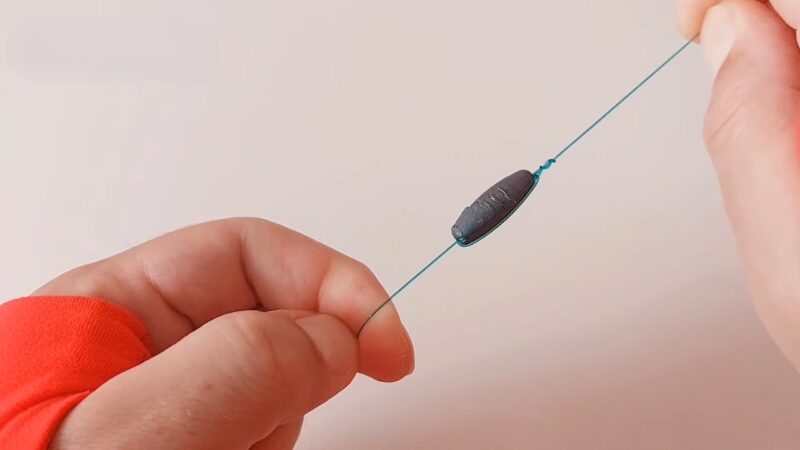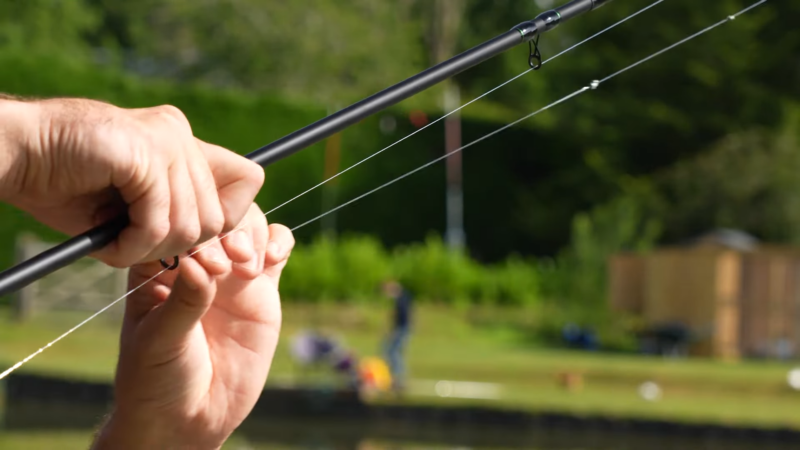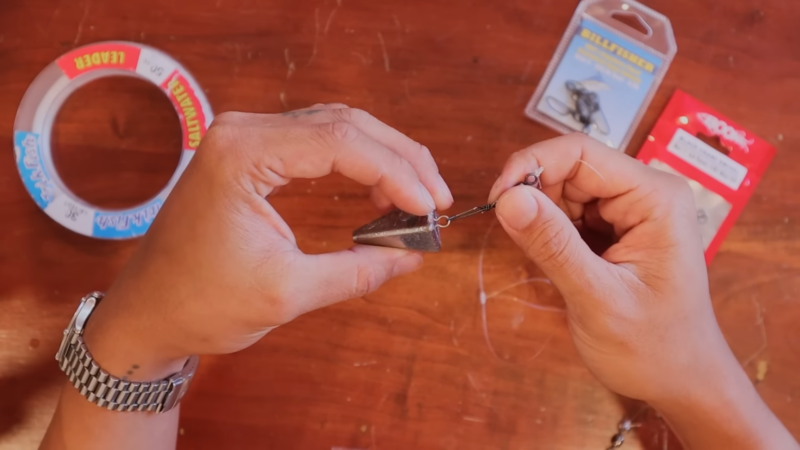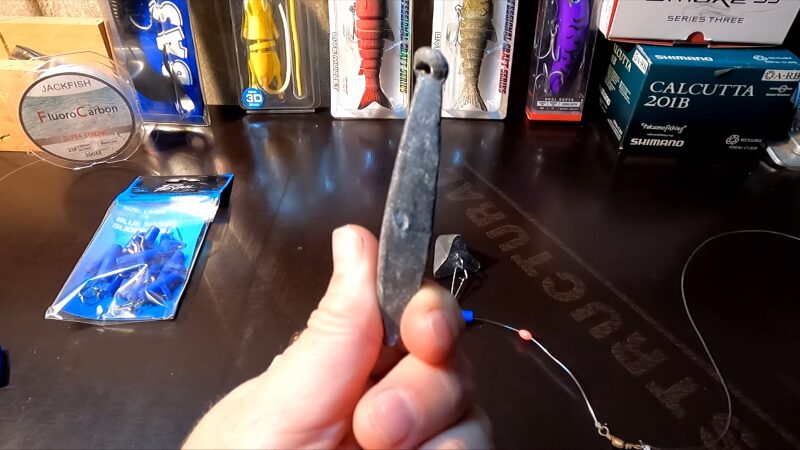Fishing sinkers are essential for getting your bait to the right depth, improving your chances of catching fish.
You can use the Uni Knot or the Palomar Knot to put sinkers on a fishing line.
These knots will secure the sinker in place, preventing it from moving along the line and disrupting your bait presentation.
Different types of sinkers serve varied purposes. For instance, sliding sinkers like egg sinkers are ideal for bottom fishing.
They slide along the line, allowing fish to take the bait without feeling too much resistance.
Attaching Sinkers to the Line

Fixed Sinkers: Knots and Rigs
The Uni Knot and Palomar Knot are two reliable options for this purpose.
To use the Uni Knot, insert the line through the sinker’s eye, make a loop, and wrap the end around the line and through the loop 4-5 times. Tighten the knot securely. For the Palomar Knot, double the line and pass it through the sinker’s eye, tie an overhand knot, pass the sinker through the loop, and tighten.
Use rubber-core sinkers for an easy, no-knots attachment option by wrapping the rubber core around the fishing line.
Sliding Sinkers: Setup and Benefits
This allows fish to take the bait without feeling the weight of the sinker. Secure sliding sinkers with a swivel and plastic bead to protect the knot from wear.
Thread the main line through the egg sinker, add a plastic bead, and tie a swivel at the end. Attach your leader line and hook to the other end of the swivel. This rigging method is ideal for drift fishing and bottom fishing where you want to maintain bait movement and sensitivity to bites.
Safety and Secure Attachment Techniques
Always check and retie knots if they appear worn or loose. Additionally, use plastic beads between sinkers and knots to reduce friction and line damage.
When using heavy sinkers, reinforce your line by doubling the line before tying knots. This added strength minimizes breakage risks. Regularly inspect your fishing gear for wear and adjust as necessary.
Use techniques that keep the sinker stable and avoid loose attachment, which can lead to tangling or line breakage.
Types of Sinkers and Their Applications
- Split Shot Sinkers: These are small, round sinkers that can be pinched onto the line. They are ideal for adjusting the weight incrementally.
- Egg Sinkers: Shaped like an egg, these have a hole through the middle and are often used for bottom fishing. They allow the line to slide through the sinker, making them ideal for drift fishing.
- Pyramid Sinkers: Best for surf fishing, these sinkers have a pyramidal shape that anchors well in sandy or muddy bottoms.
- Bullet Sinkers: These are cone-shaped and used primarily in freshwater fishing for their tank-like design, which minimizes snagging.
- Bank Sinkers: Long and slender, these are suitable for deep-water fishing, allowing the bait to stay at the bottom without getting tangled.
Weight and Buoyancy Considerations
The weight of the sinker you choose should match the conditions you’re fishing in. Heavier sinkers are typically used in fast-moving water or deep-sea fishing, where you need to keep the bait at a specific depth.
Lighter sinkers are ideal for shallow waters or slow-moving currents, offering subtle bait presentation.
Buoyancy is another factor. If you’re fishing in an area with a lot of vegetation or obstacles, you’ll need a sinker that can maintain the bait’s position without getting snagged.
Combining weights for balance can also be useful. For instance, a heavier sinker might be placed at the bottom with lighter ones above it to create a balanced setup.
Understanding these factors allows you to choose the most effective sinker for your fishing needs.
Fishing Line Basics

- Monofilament lines are made from a single strand of material. They are highly versatile and easy to use, making them ideal for beginners. Monofilament offers good elasticity, which helps prevent the hook from tearing out of a fish’s mouth. However, it is more susceptible to abrasion.
- Braided lines consist of multiple strands woven together. They are known for their high strength-to-diameter ratio, making them suitable for heavy cover and deep-sea fishing. Braided lines have little to no stretch, providing better sensitivity. However, they are more visible underwater, which might deter some fish.
- Fluorocarbon lines are nearly invisible underwater due to their light-refractive properties. They are highly abrasion-resistant and have low stretch, providing excellent sensitivity. These lines are particularly effective in clear water. Nevertheless, they are generally stiffer than monofilament and can be more difficult to handle.
Line Strength and Diameter
Line strength, also known as a test, is measured in pounds. It indicates the maximum weight the line can handle before breaking. For freshwater fishing, 4-12 lb test lines are common, while saltwater fishing typically requires 12-60 lb test lines, depending on the target species.
Diameter affects the line’s visibility, stretch, and strength. Thinner lines are less visible and offer more natural bait movement but may lack strength. Thicker lines provide added strength but can be more noticeable to fish. Assess the type of fish you’re targeting and the water conditions to determine the best balance between strength and diameter.
Selecting the Right Sinker for Your Fishing Line

The weight of your sinker must be suitable for the fishing environment. In moving waters, such as rivers or oceans, you need a heavier sinker to keep your bait in place. Conversely, still, waters like lakes or ponds require lighter sinkers to avoid frightening fish.
- Stream and River Fishing: Use heavier sinkers like pyramid or bank sinkers to prevent the current from dragging your bait away.
- Lake and Pond Fishing: Lighter options like split-shot sinkers are ideal for minimal disturbance and natural bait presentation.
- Surf Fishing: Consider spider sinkers, which grip sandy bottoms effectively, preventing movement caused by waves.
Compatibility with Line Type and Target Species
Your sinker must be compatible with your fishing line and the species you’re targeting. This ensures that the line remains intact and bait appeals to the intended fish without unnecessary line stress.
- Line Types: For braided lines, use sinkers with smooth finishes to avoid line damage. Monofilament lines pair well with almost any sinker type, while fluorocarbon lines need sinkers that don’t abrade easily.
- Target Species: Select larger sinkers for species like catfish or carp that dwell at the bottom. For smaller species such as trout, stick to lightweight sinkers that ensure gentle bait delivery.
Practical Tips

Depth Adjustment and Testing
Start by sliding a sliding sinker, such as an egg sinker, onto your main fishing line. Use a swivel to stop the sinker from sliding down to the bait. This method is ideal for drift or bottom fishing.
Next, cast your line and observe how quickly the sinker takes your bait to the target depth. Adjust as needed by changing sinker sizes or adding more weight. For shallow waters, lighter sinkers are better. Heavier sinkers work well in deeper waters or stronger currents.
Detecting Bites with Varying Sinker Sizes
Larger sinkers are heavier and better suited for turbulent waters. They can also help anchor your bait in place, especially when using live minnows or other natural baits that crappie love.
Smaller sinkers are more sensitive and let you detect lighter bites. When fishing in calm waters or targeting smaller fish, smaller sinkers give you better bite detection.








